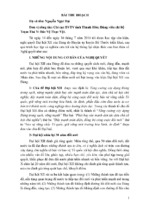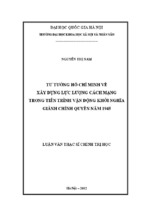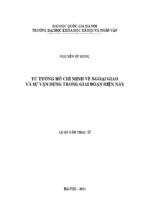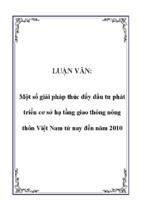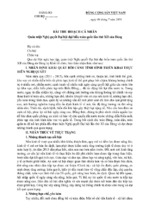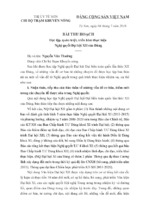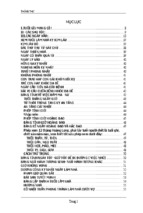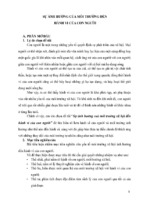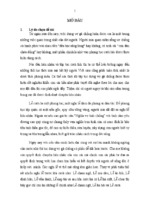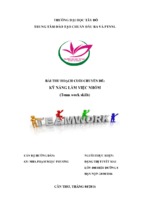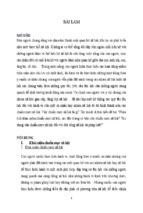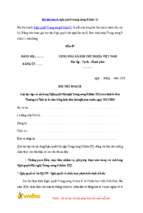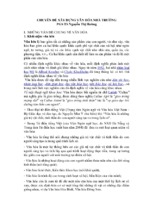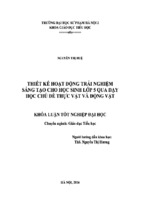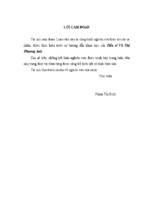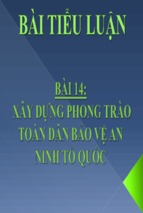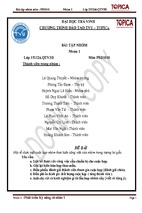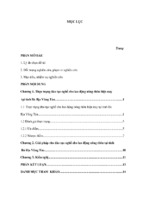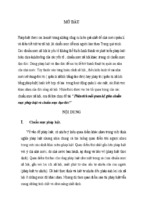Pictures can move people, stir up curiosity, provide inspiration and motivation
for speaking, and generally enhance learners’ classroom experience (Keddie, 2009:7) .
With the use of pictures in speaking activities, the current research aims at (1)
investigating to what extent young learners can improve their speaking skill, and (2)
exploring their attitudes towards the use of pictures in the activities.
To achieve the first purpose of the study, the author conducted an experimental
research at New Oriental English School with the use of pictures in speaking activities
for the Experimental group (EG) consisting of sixteen students, and without the use of
pictures in speaking activities for the Control group (CG) consisting of sixteen
students. To measure the development of learners’ speaking skill before and after the
treatment, the researcher used a pre-test and a post-post to compare the mean scores of
the two groups. As a result, although there was no statistically significant difference
between the two groups before and after the treatment, the mean scores of the post-test
showed that the EG outperformed the CG. In addition, observations, questionnaires,
and interviews were employed to explore learners’ attitudes towards the use of
pictures in speaking activities. The results revealed that learners in the EG showed
their great interests and motivation, and responded positively to wards the application
of pictures in learning speaking.
Finally, basing on the findings, the research offered some recommendations for
teachers and school administrators and suggestions for further research relating to the
use of pictures in teaching and learning English, especially for teaching and learning
English speaking skill.
v
TABLES OF CONTENTS
STATEMENT OF AUTHORSHIP.................................................................................. i
RETENTION AND USE OF THE THESIS….. ............................................................. ii
ACKNOWLEDGEMENT ............................................................................................... iii
ABSTRACT….. ................................................................................................................ iv
TABLE OF CONTENTS .................................................................................................. v
LIST OF FIGURES, CHARTS AND TABLES….. ....................................................... x
ABBREVIATIONS.......................................................................................................... xii
Chapter 1: INTRODUCTION.......................................................................................... 1
1.1. Statement of the problem.............................................................................................. 2
1.2. Statements of the purpose ............................................................................................. 3
1.3. Research questions ....................................................................................................... 3
1.4. Significance of the study .............................................................................................. 4
1.5. Limitation of the Study ................................................................................................. 4
1.6. The Organization of the Study ..................................................................................... 4
Chapter 2: LITERATURE REVIEW ............................................................................. 6
2.1. Communicative competence ....................................................................................... 6
2.1.1. Communicative language teaching ................................................................. 7
2.1.2 The practice of teaching and learning speaking skill in classroom .................. 8
2.1.3. The teaching of spoken language functions in classroom activities ................ 9
2.1.4. Children proficiency of learning spoken language......................................... 12
2.1.5. Children’s ability for meaning negotiation and demands for more complex
tasks ................................................................................................................ 13
2.1.5.1. Children’s ability for meaning negotiation .................................................. 13
2.1.5.2. Children’s demands for more complex tasks ............................................... 13
2.2. The use of visual aids in language teaching ............................................................... 14
2.2.1. Definitions of pictures ................................................................................... 15
2.2.2. Types of pictures ........................................................................................... 16
vi
2.2.3. Activities used with pictures to teach oral skills for children ....................... 17
2.3. The importance of motivation in language teaching and learning activities .............. 18
2.3.1. Types of motivation ....................................................................................... 18
2.3.2. Factors and elements of motivation............................................................... 19
2.3.3. Maintaining learners’ motivation .................................................................. 20
2.4. Previous studies and articles related to the current research ...................................... 21
Chapter 3: RESEARCH METHODOLOGY….. ......................................................... 24
3.1. Research context ......................................................................................................... 24
3.1.1. Research site ................................................................................................. 24
3.1.2. Teaching materials........................................................................................ 25
3.1.3. The main teaching staff ................................................................................ 25
3.1.4. The current teaching and learning English speaking skill at NOES ............ 25
3.2. The population of the research ................................................................................... 26
3.2.1. Research samples.......................................................................................... 26
3.3. Research design .......................................................................................................... 30
3.4. Design of lesson plans for CG and EG ....................................................................... 32
3.4.1 A description of the lesson plan for the CG .................................................. 32
3.4.2. A description of the lesson plan for the EG ................................................. 34
3.5. Research Instruments.................................................................................................. 36
3.5.1. The pre-test and post-test design .................................................................. 37
3.5.1.1. The pre-test contents ................................................................................. 40
3.5.1.2. The post-test contents ................................................................................ 40
3.5.2. Observation................................................................................................... 41
3.5.3. Survey Questionnaire ................................................................................... 43
3.5.4. Interview ....................................................................................................... 47
3.6. Procedures of data collection...................................................................................... 48
3.7. Analytical framework ................................................................................................ 49
3.7.1. Experimental data analysis ........................................................................... 50
3.7.1.1. Mean (X) ................................................................................................... 50
3.7.1.2 Standard Deviation (S.D.) .......................................................................... 50
vii
3.7.1.3. Independent samples T-test ....................................................................... 50
3.7.1.4. Pair samples T-test .................................................................................... 50
3.7.2. Descriptive data analysis .............................................................................. 51
3.7.2.1. Frequencies (f) ........................................................................................... 51
3.7.2.2. Percentages (%) ......................................................................................... 51
3.7.3. Content analysis............................................................................................ 51
CHAPTER 4: FINDINGS OF THE STUDY ................................................................ 53
4.1. Participants’ performance at pre-test and post-test .................................................... 53
4.1.1. Comparisons of Mean scores and Independent Samples T-test of CG and
EG in Pre-test ........................................................................................................... 54
4.1.2. Comparisons of paired samples T-test of CG and EG after treatment .......... 54
4.1.2.1. Paired samples T-test of CG on Pre-test and Post-test ............................... 54
4.1.2.2. Paired samples T-test of EG on Pre-test and Post-test ............................... 55
4.1.2.3 An Independent Samples T-test of CG and EG on Post-test ....................... 56
4.2. Learners’ attitudes toward the use of pictures in speaking activities ......................... 57
4.2.1. Analysis of observations for EG .................................................................... 57
4.2.2. Results of the research questionnaires ........................................................... 59
4.2.2.1. Learners’ opinions about the use of pictures in speaking English ............. 59
4.2.2.2. Levels of learners’ interest in speaking activities through pictures............ 62
4.2.2.3. Learners’ evaluation on the levels of difficulty for each activity with the
use of pictures in speaking ....................................................................................... 65
4.2.2.4.Learners’ recommendations or suggestions................................................. 68
4.2.3. Results of the interviews ................................................................................ 59
4.2.3.1. Learners' opinions about the use of pictures in speaking ........................... 59
4.2.3.2. Learners’ opinions about speaking activities through pictures .................. 70
4.2.3.3. Learners’ perspectives on the helpfulness of pictures in speaking
activities ................................................................................................................... 73
4.2.3.4. Learners’ suggestions about the use of pictures in speaking activities ...... 74
Chapter 5: Discussions of the findings.......................................................................... 76
viii
5.1. To what extent the use of pictures affects the development of the learners’
speaking skill ..................................................................................................................... 76
5.2. Learners’ attitudes toward the use of pictures in speaking activities ......................... 77
5.2.1. Learners’ interest and motivation about the use of pictures in English
speaking ................................................................................................................... 77
5.2.2. Learners’ opinions about the usefulness of pictures in speaking English ..... 78
5.2.3. Learners’ responses to specific speaking activity through pictures .............. 79
5.2.3.1. Talk as transaction (Information exchanging) ............................................ 79
5.2.3.2. Talk as performance (Information presenting) ........................................... 80
5.2.4. Learners’ recommendations or suggestions................................................... 82
5.3. Chapter Conclusion .................................................................................................... 82
CHAPTER 6: CONCLUSION AND RECOMMENDATIONS ................................. 84
6.1. Conclusion .................................................................................................................. 84
6.1.1. Effectiveness of using pictures to enhance learners’ speaking skill ............... 84
6.1.2. Learners’ attitudes towards the use of pictures in speaking activities ............ 84
6.2. Limitations of the research ......................................................................................... 84
6.3. Recommendations ...................................................................................................... 86
6.3.1. Recommendations for teachers and the school administrators ....................... 86
6.3.2. Recommendations for further research ........................................................... 88
6.4. Contribution of the study ............................................................................................ 88
REFERENCES ................................................................................................................ 89
APPENDIXES.................................................................................................................. 95
Appendix A: A sample of a lesson plan for the Control Group ....................................... 95
Appendix B: A sample of the lesson plan for the Experimental Group ............................ 97
Appendix C: A description of speaking assessment criteria ............................................. 89
Appendix D: Pre-test handout ......................................................................................... 100
Appendix E: Post-test handout ........................................................................................ 103
Appendix F: The Observation Checklist ......................................................................... 106
ix
Appendix G: Pre-survey questionnaire for teachers........................................................ 107
Appendix I: Questionnaire for students ........................................................................... 109
Appendix H: Interview questions for learner participants .............................................. 112
Appendix J: Sample Transcripts of students’ performance in Speaking Pre-test ........... 114
Appendix J1: Sample Transcripts of CG in Speaking Pre-test ........................... 114
Appendix J2: Sample Transcripts of EG in Speaking Pre-test............................. 121
Appendix K: Sample Transcripts of CG and EG in Speaking Post-test ......................... 128
Appendix K1: Sample Transcripts of CG in Speaking Post-test ......................... 128
Appendix K2: Sample Transcripts of EG in Speaking Post-test .......................... 135
Appendix L: Results of CG Pre-test and Post-test .......................................................... 141
Appendix M: Results of EG Pre-test and Post-test ......................................................... 142
Appendix N: Results of Observation Checklists ............................................................. 143
Appendix O: Results of Pre-survey Questionnaire for teachers...................................... 144
Appendix P: Results of questionnaire for students.......................................................... 145
Appendix Q: Results of interviews with students ........................................................... 149
MINISTRY OF EDUCATION AND TRAINING
HO CHI MINH CITY OPEN UNIVERSITY
THE USE OF PICTURES TO ENGAGE YOUNG LEARNERS IN
SPEAKING ACTIVITIES AT NEW ORIENTAL ENGLISH SCHOOL
Major: TEACHING ENGLISH TO SPEAKERS OF OTHER LANGUAGES
Major code: 60140111
MASTER OF ARTS IN TESOL
Supervisor: HO THANH MY PHUONG, Ph.D.
HO CHI MINH City, 2015
STATEMENT OF AUTHORSHIP
I certify my authorship of the thesis submitted today entitled, “The use of
pictures to engage young learners in speaking activities at New Oriental English
School” as the statement of requirements for thesis in Master’s Programs at Ho Chi
Minh City Open University, issued by the Higher Degree Committee.
Except where reference is made in the text of the thesis, this thesis does not
contain material published elsewhere or extracted in whole or in part from a thesis by
which I have qualified for or been awarded another degree or diploma.
No other person’s work has been used without due acknowledgement in the
main text of the thesis.
This thesis has not been submitted for any degree in any other tertiary
institution.
Ho Chi Minh City, October 2015
NGUYEN VU ANH DUY
i
RETENTION AND USE OF THE THESIS
I hereby state that I, Nguyen Vu Anh Duy, being the candidate for the degree
of Master of TESOL, accept the requirements of the University relating to the
retention and use of Master’s Theses deposited in the Library.
In terms of these conditions, I agree that the original of my thesis deposited in
the Library should be accessible for purposes of study and research, in accordance
with the normal conditions established by the Library for the care, loan, or
reproduction of theses.
ii
ABSTRACT
Pictures can move people, stir up curiosity, provide inspiration and motivation
for speaking, and generally enhance learners’ classroom experience (Keddie, 2009:7).
With the use of pictures in speaking activities, the current research aims at (1)
investigating to what extent young learners can improve their speaking skill, and (2)
exploring their attitudes towards the use of pictures in the activities.
To achieve the first purpose of the study, the author conducted an experimental
research at New Oriental English School with the use of pictures in speaking activities
for the Experimental group (EG) consisting of sixteen students, and without the use of
pictures in speaking activities for the Control group (CG) consisting of sixteen
students. To measure the development of learners’ speaking skill before and after the
treatment, the researcher used a pre-test and a post-post to compare the mean scores of
the two groups. As a result, although there was no statistically significant difference
between the two groups before and after the treatment, the mean scores of the post-test
showed that the EG outperformed the CG. In addition, observations, questionnaires,
and interviews were employed to explore learners’ attitudes towards the use of
pictures in speaking activities. The results revealed that learners in the EG showed
their great interests and motivation, and responded positively towards the application
of pictures in learning speaking.
Finally, basing on the findings, the research offered some recommendations for
teachers and school administrators and suggestions for further research relating to the
use of pictures in teaching and learning English, especially for teaching and learning
English speaking skill.
iv
TABLES OF CONTENTS
STATEMENT OF AUTHORSHIP.................................................................................. i
RETENTION AND USE OF THE THESIS….. .............................................................ii
ACKNOWLEDGEMENT ...............................................................................................iii
ABSTRACT….. ................................................................................................................ iv
TABLE OF CONTENTS .................................................................................................. v
LIST OF FIGURES, CHARTS AND TABLES….. ....................................................... x
ABBREVIATIONS..........................................................................................................xii
Chapter 1: INTRODUCTION.......................................................................................... 1
1.1. Statement of the problem.............................................................................................. 2
1.2. Statements of the purpose............................................................................................. 3
1.3. Research questions ....................................................................................................... 3
1.4. Significance of the study .............................................................................................. 4
1.5. Limitation of the Study................................................................................................. 4
1.6. The Organization of the Study ..................................................................................... 4
Chapter 2: LITERATURE REVIEW ............................................................................. 6
2.1. Communicative competence ....................................................................................... 6
2.1.1. Communicative language teaching ................................................................. 7
2.1.2 The practice of teaching and learning speaking skill in classroom .................. 8
2.1.3. The teaching of spoken language functions in classroom activities ................ 9
2.1.4. Children proficiency of learning spoken language......................................... 12
2.1.5. Children’s ability for meaning negotiation and demands for more complex
tasks................................................................................................................ 13
2.1.5.1. Children’s ability for meaning negotiation .................................................. 13
2.1.5.2. Children’s demands for more complex tasks ............................................... 13
2.2. The use of visual aids in language teaching ............................................................... 14
2.2.1. Definitions of pictures ................................................................................... 15
2.2.2. Types of pictures ........................................................................................... 16
v
2.2.3. Activities used with pictures to teach oral skills for children ....................... 17
2.3. The importance of motivation in language teaching and learning activities.............. 18
2.3.1. Types of motivation....................................................................................... 18
2.3.2. Factors and elements of motivation............................................................... 19
2.3.3. Maintaining learners’ motivation .................................................................. 20
2.4. Previous studies and articles related to the current research ...................................... 21
Chapter 3: RESEARCH METHODOLOGY….. ......................................................... 24
3.1. Research context......................................................................................................... 24
3.1.1. Research site ................................................................................................. 24
3.1.2. Teaching materials........................................................................................ 25
3.1.3. The main teaching staff ................................................................................ 25
3.1.4. The current teaching and learning English speaking skill at NOES ............ 25
3.2. The population of the research ................................................................................... 26
3.2.1. Research samples.......................................................................................... 26
3.3. Research design .......................................................................................................... 30
3.4. Design of lesson plans for CG and EG....................................................................... 32
3.4.1 A description of the lesson plan for the CG .................................................. 32
3.4.2. A description of the lesson plan for the EG ................................................. 34
3.5. Research Instruments.................................................................................................. 36
3.5.1. The pre-test and post-test design .................................................................. 37
3.5.1.1. The pre-test contents ................................................................................. 40
3.5.1.2. The post-test contents ................................................................................ 40
3.5.2. Observation................................................................................................... 41
3.5.3. Survey Questionnaire ................................................................................... 43
3.5.4. Interview....................................................................................................... 47
3.6. Procedures of data collection...................................................................................... 48
3.7. Analytical framework ................................................................................................ 49
3.7.1. Experimental data analysis ........................................................................... 50
3.7.1.1. Mean (X) ................................................................................................... 50
3.7.1.2 Standard Deviation (S.D.) .......................................................................... 50
vi
3.7.1.3. Independent samples T-test ....................................................................... 50
3.7.1.4. Pair samples T-test .................................................................................... 50
3.7.2. Descriptive data analysis .............................................................................. 51
3.7.2.1. Frequencies (f)........................................................................................... 51
3.7.2.2. Percentages (%) ......................................................................................... 51
3.7.3. Content analysis............................................................................................ 51
CHAPTER 4: FINDINGS OF THE STUDY ................................................................ 53
4.1. Participants’ performance at pre-test and post-test .................................................... 53
4.1.1. Comparisons of Mean scores and Independent Samples T-test of CG and
EG in Pre-test........................................................................................................... 54
4.1.2. Comparisons of paired samples T-test of CG and EG after treatment .......... 54
4.1.2.1. Paired samples T-test of CG on Pre-test and Post-test ............................... 54
4.1.2.2. Paired samples T-test of EG on Pre-test and Post-test ............................... 55
4.1.2.3 An Independent Samples T-test of CG and EG on Post-test ....................... 56
4.2. Learners’ attitudes toward the use of pictures in speaking activities ......................... 57
4.2.1. Analysis of observations for EG.................................................................... 57
4.2.2. Results of the research questionnaires ........................................................... 59
4.2.2.1. Learners’ opinions about the use of pictures in speaking English ............. 59
4.2.2.2. Levels of learners’ interest in speaking activities through pictures............ 62
4.2.2.3. Learners’ evaluation on the levels of difficulty for each activity with the
use of pictures in speaking....................................................................................... 65
4.2.2.4.Learners’ recommendations or suggestions................................................. 68
4.2.3. Results of the interviews................................................................................ 59
4.2.3.1. Learners' opinions about the use of pictures in speaking ........................... 59
4.2.3.2. Learners’ opinions about speaking activities through pictures .................. 70
4.2.3.3. Learners’ perspectives on the helpfulness of pictures in speaking
activities ................................................................................................................... 73
4.2.3.4. Learners’ suggestions about the use of pictures in speaking activities ...... 74
Chapter 5: Discussions of the findings.......................................................................... 76
vii
5.1. To what extent the use of pictures affects the development of the learners’
speaking skill ..................................................................................................................... 76
5.2. Learners’ attitudes toward the use of pictures in speaking activities ......................... 77
5.2.1. Learners’ interest and motivation about the use of pictures in English
speaking ................................................................................................................... 77
5.2.2. Learners’ opinions about the usefulness of pictures in speaking English ..... 78
5.2.3. Learners’ responses to specific speaking activity through pictures .............. 79
5.2.3.1. Talk as transaction (Information exchanging) ............................................ 79
5.2.3.2. Talk as performance (Information presenting) ........................................... 80
5.2.4. Learners’ recommendations or suggestions................................................... 82
5.3. Chapter Conclusion .................................................................................................... 82
CHAPTER 6: CONCLUSION AND RECOMMENDATIONS ................................. 84
6.1. Conclusion .................................................................................................................. 84
6.1.1. Effectiveness of using pictures to enhance learners’ speaking skill ............... 84
6.1.2. Learners’ attitudes towards the use of pictures in speaking activities ............ 84
6.2. Limitations of the research ......................................................................................... 84
6.3. Recommendations ...................................................................................................... 86
6.3.1. Recommendations for teachers and the school administrators ....................... 86
6.3.2. Recommendations for further research ........................................................... 88
6.4. Contribution of the study............................................................................................ 88
REFERENCES ................................................................................................................ 89
APPENDIXES.................................................................................................................. 95
Appendix A: A sample of a lesson plan for the Control Group ....................................... 95
Appendix B: A sample of the lesson plan for the Experimental Group............................ 97
Appendix C: A description of speaking assessment criteria ............................................. 89
Appendix D: Pre-test handout ......................................................................................... 100
Appendix E: Post-test handout ........................................................................................ 103
Appendix F: The Observation Checklist ......................................................................... 106
viii
Appendix G: Pre-survey questionnaire for teachers........................................................ 107
Appendix I: Questionnaire for students........................................................................... 109
Appendix H: Interview questions for learner participants .............................................. 112
Appendix J: Sample Transcripts of students’ performance in Speaking Pre-test ........... 114
Appendix J1: Sample Transcripts of CG in Speaking Pre-test ........................... 114
Appendix J2: Sample Transcripts of EG in Speaking Pre-test............................. 121
Appendix K: Sample Transcripts of CG and EG in Speaking Post-test ......................... 128
Appendix K1: Sample Transcripts of CG in Speaking Post-test ......................... 128
Appendix K2: Sample Transcripts of EG in Speaking Post-test.......................... 135
Appendix L: Results of CG Pre-test and Post-test .......................................................... 141
Appendix M: Results of EG Pre-test and Post-test ......................................................... 142
Appendix N: Results of Observation Checklists ............................................................. 143
Appendix O: Results of Pre-survey Questionnaire for teachers...................................... 144
Appendix P: Results of questionnaire for students.......................................................... 145
Appendix Q: Results of interviews with students ........................................................... 149
ix
LIST OF TABLES, CHARTS AND FIGURES
TABLES
Table 3.1.: Criterion to rank students ................................................................................ 24
Table 3.2: The learner population of the research............................................................. 27
Table 3.3: Summary of five Teen 5 classes...................................................................... 28
Table 3.4: The Homogeneity and Distinctions between the Two Classes ........................... 30
Table 3.5: Structure of Experimental Design .................................................................... 31
Table 3.6: Description of lesson plans for the CG ............................................................ 33
Table 3.7: Description of the lesson plan for the EG ........................................................ 35
Table 3.8: Summary of the speaking-test design............................................................... 37
Table 3.9: The description of the pre-test contents ........................................................... 39
Table 3.10: The description of the post-test contents........................................................ 41
Table 3.11: Summary of the content of the observation checklist for EG ........................ 42
Table 3.12: Summary of class visits for EG...................................................................... 43
Table 3.13: Summary of the content of the questionnaires for EG ................................... 44
Table 3.14: Summary of participants in the piloting stage................................................ 45
Table 3.15: Items reserved, changed, and deleted in the piloting questionnaire............... 45
Table 3.16. Procedure and duration of conducting questionnaires for EG ....................... 47
Table 3.17: Procedure of conducting interviews for EG................................................... 48
Table 3.18: Procedures of data collection ......................................................................... 49
Table 4.1: Group Statistics on Pre-test of CG and EG ...................................................... 53
Table 4.2: Results of Independent Samples T-test on Pre-test of CG and EG................. 53
Table 4.3: Paired Samples Group Statistics of Control Group Pre-test and Post-test....... 54
Table 4.4: Results of paired samples test of Control Group Pre-test and Post-test.......... 55
Table 4.5: Paired Samples Group Statistics of Experimental Group Pre-test and Posttest...................................................................................................................................... 55
Table 4.6: Results of Paired Samples T-Test for Experimental Group Pre-test and
Post-test ............................................................................................................................. 56
Table 4.7: Group Statistics on the post-test of CG and EG............................................... 56
Table 4.8: Results of independent samples T-test on the post-test of CG and EG .......... 57
x
Table 4.9: Students’ recommendations and suggestions for using pictures in speaking
activities in the questionnaire ............................................................................................ 68
Table 4.10: Reasons for why students like and dislike the activities ................................ 72
Table 4.11: Participants' interest in giving suggestions/ opinions .................................... 74
Table 4.12: Learners’ suggestions/ opinions to improve the use of pictures in speaking
activities in the interview................................................................................................... 75
CHARTS
Chart 3.1: Levels selected randomly ................................................................................. 28
Chart 3.2: Control and Experimental group selection ....................................................... 29
Chart 3.3: Summary of study process................................................................................ 32
Figures
Figure 4.1: The results of learners’ attitudes towards the use of pictures in speaking
activities from the observations......................................................................................... 58
Figure 4.2: Student’s interest and motivation towards the use of pictures in English
speaking activities.............................................................................................................. 60
Figure 4.3: Students’ opinions about the usefulness of pictures in learning English
speaking ............................................................................................................................. 62
Figure 4.4: Levels of students’ interest about the use of pictures in in information
exchanging activities ......................................................................................................... 63
Figure 4.5: Levels of students’ interest about the use of pictures in in information
presenting activities ........................................................................................................... 64
Table 4.6: Levels of difficulty in for information exchanging activities with the use of
pictures............................................................................................................................... 66
Figure 4.7: Levels of difficulty in information presenting with the use of pictures ......... 67
Figure 4.8: Learners’ interests in learning English speaking through pictures ................. 69
Figure 4.9: Reasons for learners’ interest in English speaking through pictures .............. 70
Figure 4.10: Students’ interest in speaking activities through pictures............................. 71
Figure 4.11: Pictures are helpful in speaking activities..................................................... 73
Figure 4.12: Students’ expression of the usefulness of pictures in speaking .................... 73
xi
ABBREVIATIONS
CC
Communicative Competence
CG
Control Group
CLT
Communicative Language Teaching
EG
Experimental Group
EFL
English as a Foreign Language
ELT
English Language Teaching
FLT
Foreign Language Teaching
MOET
Ministry of Education and Training
NOES
New Oriental English School
PET
Preliminary English Test
xii
CHAPTER 1: INTRODUCTION
I. Introduction/ Background of the study
For centuries in the history of foreign language teaching and learning, pictures
have been used to help learners understand various aspects of foreign languages and
promote language-learning motivation among learners (Wright, 1989: 136, 162-163).
In fact, pictures or visual aids might not only lead students to creativity and contribute
richly to the development of human intelligence, but also offer means to reach the
great diversity of human being in classroom environment (Pugliese, 2010: 44-45).
Pictures (visual images) can be used at all levels of language learning, from beginners
to advanced (John, 2003: 140). Pictures or images can move people, stir up curiosity,
provide inspiration and motivation for writing as well as speaking, and generally
enhance learners’ classroom experience (Keddie, 2009:7). Finally, pictures have been
used to provide learners with real opportunities to communicate whether in pairs or in
groups (Wright, 1989: 162-163).
By so far, a large number of studies have proved for the power of pictures in
language teaching and learning. One of recent studies by Suli (2013) claimed that
using picture series in writing instruction could be really effective and helpful to
learners at grade eighth. Another research by Pešková (2008) indicated that learning
with pictures, learners had a great opportunity to interact with their peers and
expressed themselves to others. It is obvious that pictures can help learners with their
productive skills such as writing skill in Suli (2013) and speaking skill in Pešková
(2008). Pictures can help learners with inductive skills as well as listening skill in
Rina (2012).
One of the most recent studies by Nguyen (2014) has investigated the use of
pictures in teaching vocabulary. The results showed that pictures might increase
students’ interest in learning English. Most of students and teachers expressed positive
attitudes towards the use of visual aids in English vocabulary teaching and learning. In
addition, pictures could stimulate students’ interest and help them with their
1
understandings of a topic and their realization of similarities and differences among
topics (Lai, 2000).
The above studies indicated that pictures have helped learners with their
productive skills and inductive skills, and have helped learners increase their learning
motivation in language classes and their social skills such as working in pairs and in
groups effectively.
1.1. Statements of the problems:
Considering the practice of teaching English in Viet Nam, (Barnard & Nguyen
2010, Tomlinson & Bao, 2004) indicated that Vietnamese teachers have a strong belief
in communicative activities to be able to strengthen students’ motivation in language
learning; however, they can do a little or nothing to communicative language teaching
because they are under the pressure of language teaching for examinations . As a result,
many Vietnamese students have not been successful in communication though they
are so good at linguistic structures with high grades in examinations (Barnard and
Nguyen, 2010). In addition, Hoang (2010) found that Vietnamese students are not
confident and feel embarrassed or confused in using English for communicative
purposes.
In a pre-survey of the researcher on teachers’ attitudes towards the use of
pictures in teaching English for teenagers in 2014, the result showed that many
teachers agreed that pictures were helpful in their teaching, and they mostly used
available pictures in the course books to help students mainly understand vocabulary
and learn reading skill. In addition, the survey indicated that most teachers agreed that
their students were interested in studying English through pictures. No evidence
showed that students were not interested in the use of pictures. However, the use of
pictures in teaching speaking was still ignored by many teachers. Finally, the
researcher realized that the effort to engage learners in speaking activities is always
one of the most challenging jobs for many teachers at NOES. The author of the
research is not exceptional; his wish is to find out effective ways to help learners with
their development of English speaking skill. Respecting the usefulness of pictures in
2
language teaching and learning, the current research intends to use pictures to engage
learners in their speaking activities for the following issues.
First, pictures can help learners with their productive skills (Suli, 2013; Keddie,
2009; and Pešková, 2008). Secondly, pictures could provide learners with a great
opportunity to interact with their peers and expressed themselves to others (Pešková,
2008 and Wright, 1989). Finally, pictures could help to improve learners’ motivation
in language learning and promote their social skills of working in pairs or groups
(Nguyen, 2014; Pugliese, 2010; Keddie, 2009; Pešková, 2008; Lai, 2000; and Wright,
1989).
Regarding the importance of communicative language teaching, especially the
need to speak a foreign language effectively, the current research involving in the use
of pictures to engage learners in speaking skill has the following purposes.
1.2. Statements of the purpose
The study mainly focused on the application of different types of pictures in
teaching English-speaking skill. As a result, the primary purpose of the current study
was to explore to what extent pictures can improve learners’ speaking skill. Besides,
the study aimed at investigating students’ attitudes towards the techniques based on
the use of pictures in teaching English-speaking skill. With these purposes, the
research had the following questions.
1.3. Research questions
For the purpose of the research, the current study had the following questions:
1) To what extent does the use of pictures help learners with their speaking
skill?
2) What are the learners’ attitudes towards the use of pictures in speaking
activities?
3
1.4. Significance of the study
The study explored the usefulness of pictures in EFL teaching and learning.
The success of the study will help teachers understand more about learners’ interest
and difficulties in speaking activities with the use of pictures. From that, the teachers
can find out appropriate and stimulating activities to help learners improve their
speaking skill. Finally, the study will be valuable for the school administrators to be
aware of the effectiveness of pictures as a useful tool that can help students improve
speaking skill. Therefore, the school administrators could conduct essential changes
for teaching and learning at the school, and encourage teachers to use pictures in
teaching speaking skill for teenagers.
1.5. Limitation of the study
The study cannot generalize to all kinds of learners and situations. It is better to
generalize to a small size of classroom and for learners aged between 11 and 14. In
addition, the study is limited to only two classes at NOES. Therefore, how the other
groups of ages respond to the use of pictures in speaking activities, and how the use of
pictures can help them improve speaking skill is not investigated in this study. Finally,
the study focuses on the use of pictures to help learners with their speaking skill only,
other skills are not the subject of the study.
1.6. The organization of the study/ summary of thesis research
Chapter 1: Introduction: the chapter introduces the background of the study that
leads the current research in using pictures to teach English speaking for learners at
New Oriental English Language School (NOES). In addition, the chapter presents the
purpose and the research questions of the study. Finally, the chapter draws out the
significance and limitations of the study.
Chapter 2: Literature Review: the writer tries to review theories relating to the
understanding of communicative competence and the understanding of oral
communicative competence in language teaching and learning. Stages and ways of
4
teaching English-speaking skills for learners, the influence of pictures on the teaching
of the skill, and other studies related to the study are included.
Chapter 3: Methodology: This chapter presents the context of the research site,
the population of the research as well how to select out samples for the research. In
addition, the chapter illustrates the instruments, their purposes, and reasons for
collecting and analyzing the data.
Chapter 4: Findings of the Study: this chapter presents the results of the
analysis of the data collected from the research instruments (Pre-test, post-test,
observations, questionnaires, and interviews).
Chapter 5: Discussions of the findings: the chapter gives deep discussions on
the findings of the research. In addition, the chapter draws out the similarities and
differences with other studies.
Chapter 6: Conclusion and Recommendations: the chapter summaries
important findings of the research, offers recommendations for teachers, for the school
administrators, and for further research. Limitations and contributions of the study are
included.
5
CHAPTER 2: LITERATURE REVIEW
The chapter reviews theories of communicative competence, theories of
language teaching speaking skill in general and then in specific for children. A
description of many useful and interesting activities in teaching speaking skill for
children, and studies or articles related to the current research are included as well.
2.1. Communicative competence
Theoretically, the concept of communicative competence has been defined and
developed from different approaches. First, Hymes (1972 & 1967) considered
communicative competence (CC) as the ability that “enables us to convey and
interpret messages and to negotiate meanings interpersonally within specific contexts”
(cited in Brown, 2002: 219). Cummins (1980 & 1979) identified CC by two terms
cognitive or academic language proficiency (CALP) which expresses what learners
often use in classroom exercises and tests that focus on form, and basic interpersonal
communicative skills (BICS), which refer to learners’ communicative capacity of
using language functionally in daily interpersonal exchanges (cited in Brown 2007:
219). In addition, Canale and Swain (1980) categorized CC into linguistic aspects and
functional aspects. Linguistic aspects reflect the use of the linguistic system relating to
grammatical competence and discourse competence, whereas, functional aspects
reflect sociolinguistic competence and strategic competence (cited in Brown, 2007:
219). Holmes (1990) claimed that sociolinguistic competence involves knowing how
to use language for different functions and how to use language effectively and
politely to different people (p. 374). Strategic competence reflects the ability to use
language verbally or nonverbally to deal with communication breakdowns (Canale &
Swain, 1980: 25-31).
It is clear that CC is a complex term involving many aspects such as linguistic
competence (including grammatical competence and discourse competence) and
functional competence (consisting of sociolinguistic competence and strategic
competence). Moreover, CC was reflected under the views of language as context,
language as interaction, and language as negotiation. All these aspects make
communicative language teaching more sophisticated and difficult.
6
2.1.1. Communicative language teaching
In a consideration of communicative language teaching (CLT), Brown (2007)
suggested that (1) classroom goals should focus on all the aspects of CC, not only on
grammatical or linguistic competence. (2) Language technique design ought to engage
learners in “the pragmatic, authentic, functional use of language for meaningful
purposes.” He added that the organization of language forms is not the central focus
but aspects of language that enable learners to accomplish the previous purposes
should be the focus. (3) Consideration for fluency and accuracy should be a
combination of skills in communicative techniques. However, the focus on fluency is
more important than accuracy so that learners may engage in using language
meaningfully. Finally, (4) in the communicative classroom, it is necessary for students
to use the language productively and receptively in unrehearsed contexts (pp. 241242).
Davies and Pearse (2000) revealed the same idea that a focus on language form
is important in foreign language learning, but development on leaners’ real
communication in English is the main goal of an English language course. Therefore,
they advised that communication in classroom activities should (1) establish English
as the main classroom language; (2) use topics and activities interestingly and
stimulatingly; (3) engage learners in the effort of communicating their ideas with
others more than controlling their language practice and correcting their language
mistakes (pp. 71-74). In order to reach the above purposes, Davies and Pearse (2000)
suggested that teachers should exploit what is happening and changing in the
classroom context such as weather, learners’ appearance or health etc., and outside the
classroom context such as new events in town, learners’ family, or latest programs on
TV, etc. (p.74). In addition, creating useful and amusing role-play or simulations is
helpful for teachers to engage learners in the effort of communicating with their
friends and exchanging information (Davies and Pearse, 2000: 74).
In brief, CLT focuses on all aspects of language. However, the central focus
should be on aspects that enable learners to communicate effectively in real situations.
Language accuracy should follow language fluency so that learners could use the
7
language naturally and have meaningful purposes in information exchanging with
others. CLT should be interesting and stimulating so that learners are motivated to
communicate ideas with others. Therefore, the practice of communicative language
teaching and learning should focus on the above issues to help learners with
development of speaking skill.
2.1.2. The practice of teaching and learning speaking skill in classroom
In real contexts, when enrolling in an oral conversation, speakers of a language
deal with many different things at the same time. For example, they have to listen and
understand what the other people say, express what they want to say, wait for their
turns, deal with unexpected changes of the topics, and think of something to say when
there appears a long pause in their conversations. Davies and Pearse (2000) also
agreed that speakers usually do not have much time to construct their utterances
carefully (p.74). In fact, conversations are so complicated for many learners because
they take place in real time and involve various skills. While learning to speak a
foreign language, making mistakes is not avoidable. Therefore, in the practice of
teaching and learning speaking skill in classroom, Davies and Pearse (2000) have
suggested some implications such as: (1) Teachers need to create a relaxed
atmosphere in classroom context; therefore, learners are not afraid of speaking in front
of the whole class. Pair-work and group-work should be employed in speaking
activities as many as possible so that learners do not have to face with the whole class
listening. (2) Teachers should expose learners to naturally pronounced speech as much
as possible and to integrated pronunciation work so that they can learn to pronounce
the language intelligibly and can develop speaking skills. (3) Improvement on English
fluency can be developed without any specific language focus in speaking activities.
In addition, it is a crucial thing to avoid any obsession with accuracy during the time
of fluency practice. Finally, (4) Teachers need to create chances for learners to use
previously introduced language; and to accustom learners to combining listening and
speaking in real time and in natural interaction. Davies and Pearse emphasized that the
best chance for them to do so is to get learner in the general use of English in the
classroom (p. 82).
8
- Xem thêm -

